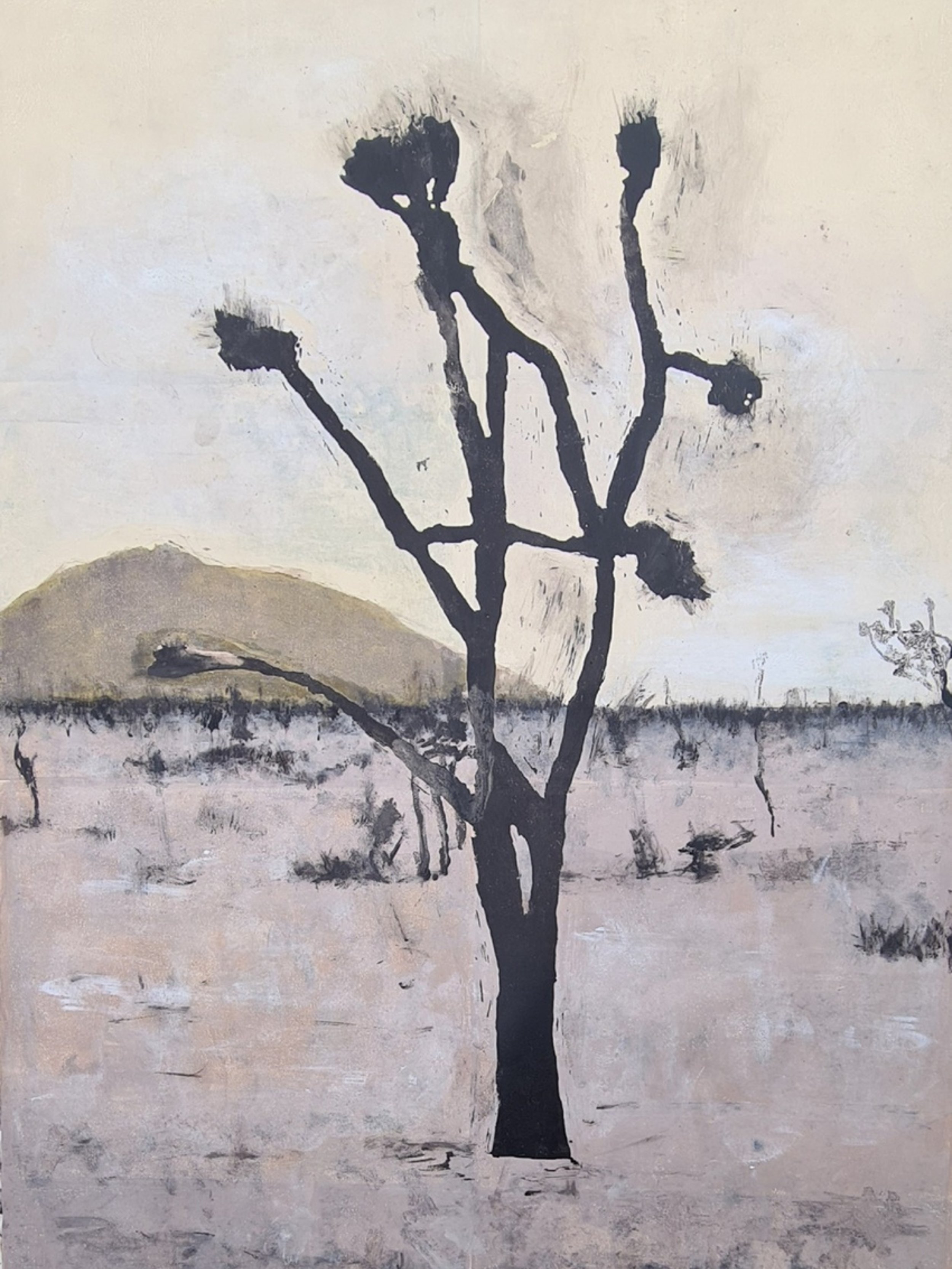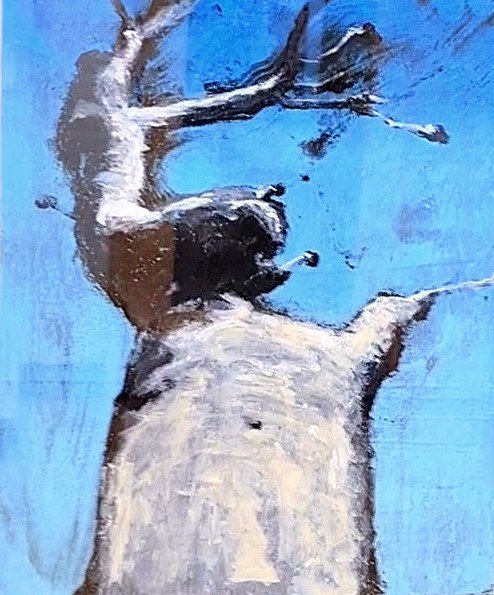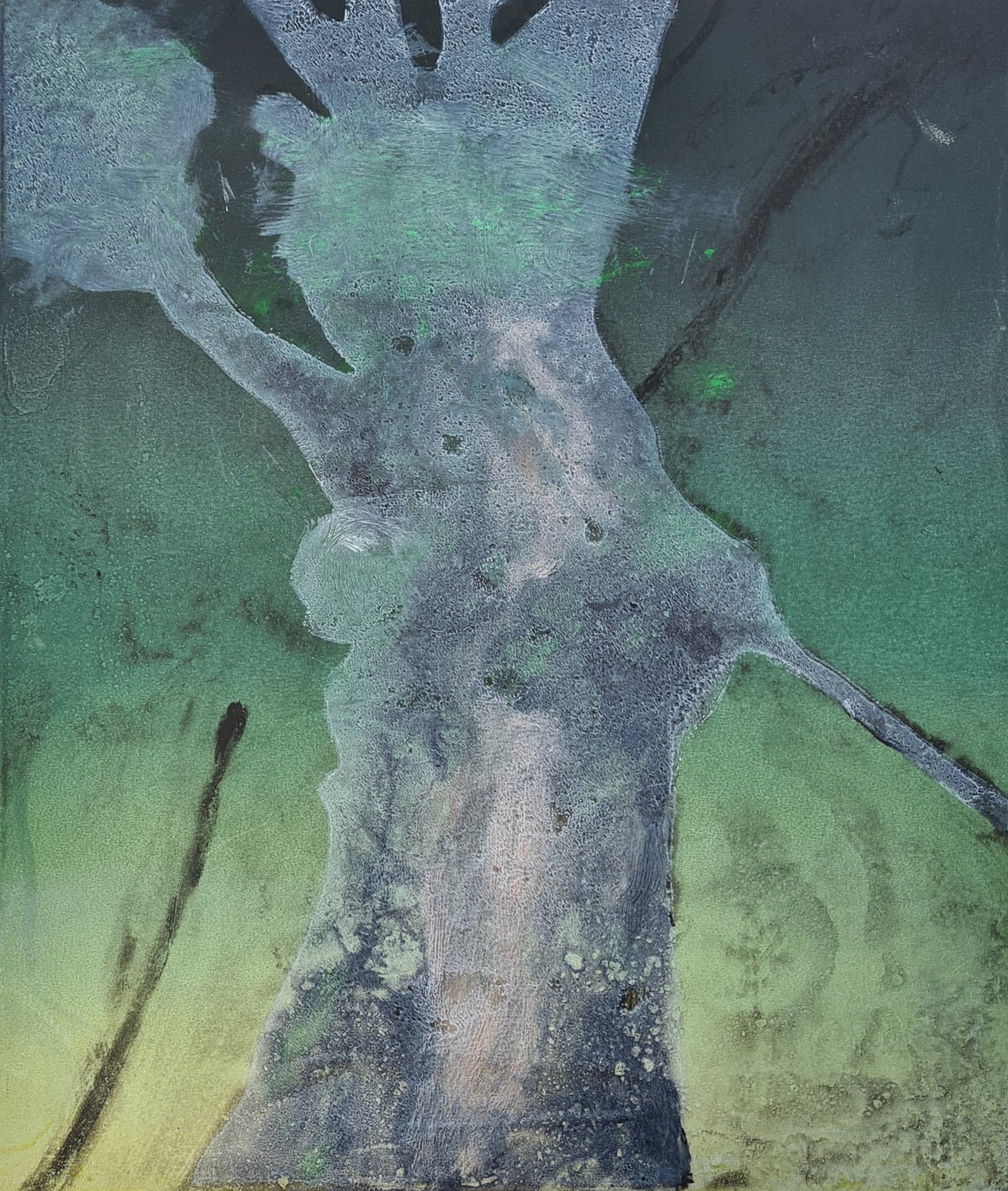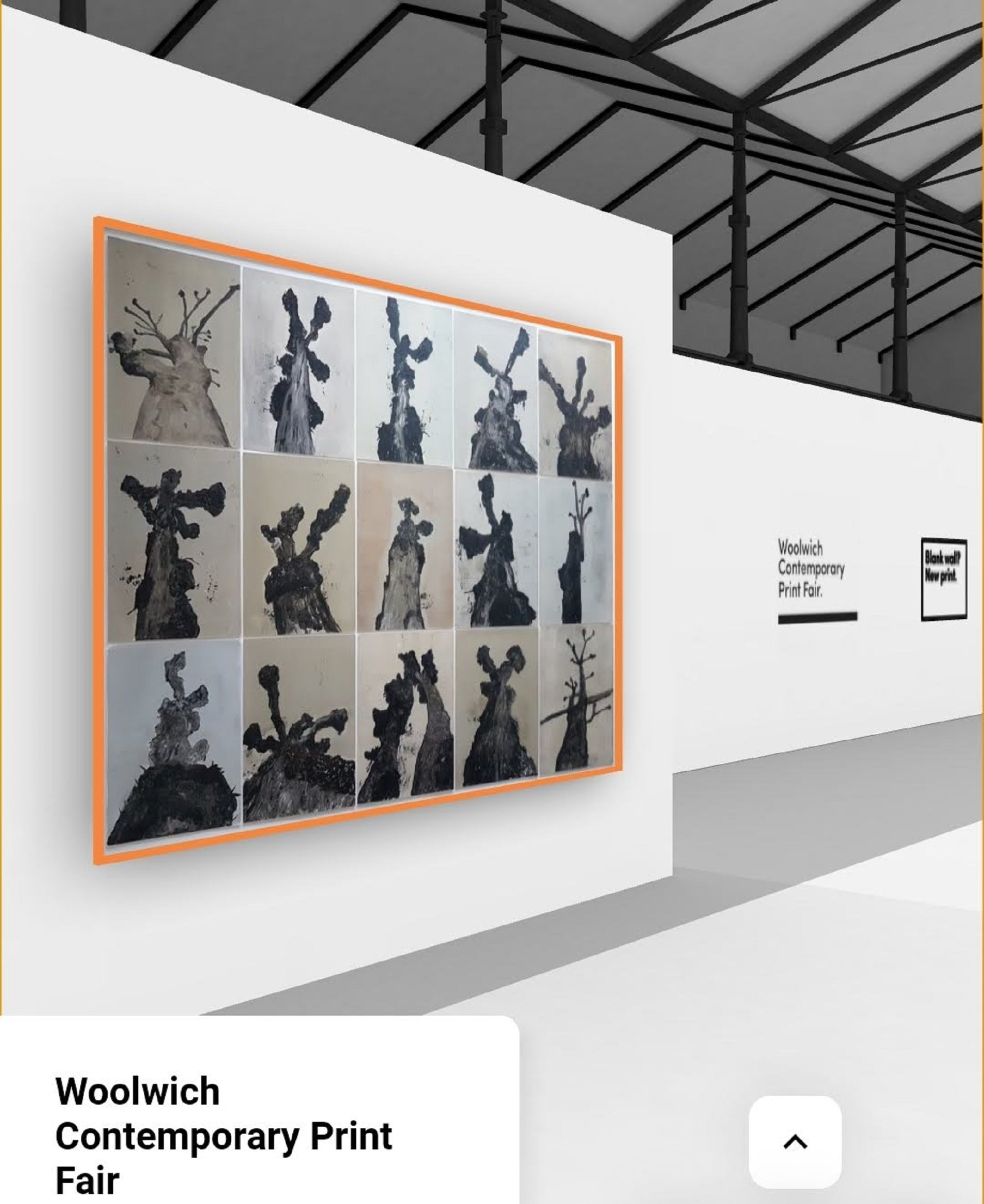Interview
Stewart Taylor
Stewart has been a printmaker for over 30 years and works from his Devon Studio, combining elements of site-specific photography, painting, and drawing.
He is continually interested in the self-inflicted demise mankind faces within our Anthropocene era, and our behavior within it. Although the outlook here is perpetually fearful and pessimistic, he tries to create a contrary world of destruction and beauty where change, metaphysics, erasure, air, and light are all of critical importance; but also where the relationships between landscape, living things and humanity are paramount.
Stewart is presently engaged in a project called the Tree Portraits which is made up of nearly 300 monoprints. These were derived from photos of street trees and trees in the parks near his previous home in East London, and also those in his new rural environs.
This series represents our broken relationship with nature, and the ongoing encroachment in the name of progress; particularly in relation to the destruction associated with the HS2 Rail Project. It’s a celebration of the trees’ struggle, and indeed all of nature’s struggles. This suite of prints has been nourished further by starting a Rewilding project minutes away from his Devon home in 2019, after being inspired the previous year by visiting the Knepp Wilding land in Sussex.
Stewart was a keyholder at East London Printmakers for over a decade, where he remains a member. He was previously the Chairman in 2008 and also Project Leader of the Mile End/Copperfield Road Studio Build for their move from London Fields in 2016.
What is your background and how did you start your journey in the art world?
“I drew fanatically from a very early age but, like many, that initial wonder and passion waned somewhat under a very stilted arts education at an academically-minded grammar school. Nonetheless, I decided to take the leap into arts during my higher education. I had the blessing of my parents who were both musicians, and always hugely supportive of my creativity.
My introduction to printmaking came very early in an etching class under Michael Fell in my foundation course at City & Guilds of London. I knew then that I was going to specialize in printmaking. The ability it gave to move drawing into an entirely different realm, particularly with regard to the metaphysical, had me hooked. I was then highly fortunate to have superb lecturers for my degree at UCA Farnham: Pete Nevin who remains a dear friend to this day, Peter Kennard, Jim Tierney, Timo Lehtonen and Sandy Sykes. They would all do anything to get students to expand their awareness, be fully conscious as artists, and contextualize one’s ideas with the medium. After graduating I joined Artichoke Print Workshop in 1997. In 2007, I joined East London Printmakers for over a decade, where I worked exclusively in screen printing.
When I started the Tree Portrait series, I experienced a lot of flexibility as this new method didn’t require a printing press of any kind, and so allowed me to print in situ when traveling. It gave me an immediacy to observing the landscape around me.”
What does your work aim to say? Does it comment on any current social or political issues?
“My current Tree Portraits series is concerned with trees’, and indeed all of nature’s struggles in the anthropocene era. These include Joshua trees from the Mojave National Preserve that were destroyed by the Cima Dome wildfire of 2020, a commission based on Canyon Oak Dieback disease in Ojai/California, and prints of deciduous trees from protected forests under traditional husbandry management by The Woodland Trust. The trust benefitted from a charity giveaway of all of these pieces and also those from the banks of the Danube in Slovakia, which were photographed for me by fellow artist Eva Boda.
Hopefully, this series will continue to help raise awareness for protecting our environment, including through donating prints for various progressive conservation/rewilding fundraisers, both in the UK and USA. I strongly believe that artists have a duty in these times to highlight the ongoing lack of action by governments, establishments and corporations—a lack of action that is magnifying and accelerating the demise of the natural world.”
Do you plan your work in advance, or is it improvisation?
"I work almost exclusively from images on my phone or my laptop. These are either taken by myself or taken by others for my use. I’m trying to recreate a sense of place and/or a feeling of unique identity regarding each individual tree, which I feel is reinforced by using monoprint as my chosen medium. There’s some level of improvisation, or certainly freedom within my processes. Monoprint has a real element of chance to it which you can ‘control’ with practice. This is particularly present within my smaller single print pieces.”
Are there any art world trends you are following?
“I’m certainly part of an ever growing number of environment and eco-based creatives. Other artists’ output is always of an interest to me, irrelevant of subject or genre, but my real focus is to continue to be part of the wider, like-minded communities of artists. That fosters a real sense of hope, which is something the world certainly needs right now.”
What process, materials and techniques do you use to create your artwork?
“Over the past 4+ years, I’ve developed a speciality for using gelliplates for all my monoprints. I was lucky enough to come across them through winning the Great Art materials prize for my screen print Alcala at the 2018 National Original Print Exhibition.
I got them initially on a practical level, as I needed to set up a studio at home without needing a press. I was hooked very quickly. They enabled extraordinary mark making qualities and allowed me to produce work at a really fast pace, even 'en plein air'. Having been wedded to time-consuming, photographic-based screen printing, this felt like an enormous creative release!
My current larger Tree Portraits have a greater sense of construction where I combine hand-cut stencils, masking fluid, and rollers to create more complex composite monoprints which still maintain the playful manner of using a gelliplate.”
“My work gradually evolved from a simple engagement with my surroundings to deeper conversations about man’s place in nature, and how man has forgotten to connect and truly engage with nature.
The ongoing Tree Portraits series emphasizes the unique character of each tree.”
What does your art mean to you?
“My work is a way for me to process the world, both beautiful and awful. I wouldn’t go as far as saying it keeps me sane, but it’s not too far off from it. My work gives me a real sense of purpose, and I’m also lucky enough to like the finished articles themselves!”
What’s your favorite artwork and why?
“I’m not sure that’s an answerable question. It’s like asking someone what their favorite song is!”
Have you had any noteworthy exhibitions you'd like to share?
“My Tree Portraits have been exhibited as multiples of 15 in both The Tree Portraits I for both Art Number 23 ‘New Era’, and the 2020 Woolwich Contemporary Print Fair Online Edition, and also The Tree Portraits II at the 16th Graphica Creativa Print Triennale in Finland 2022-23. The Jyväskylä Art Museum acquired this piece for their print collection in March 2023. You can see this here.
Cima Dome Fire VIII was selected for the 2022 Woolwich Contemporary Print Fair and was also included in co-founder Jack Bullen’s Top 10 Picks from the event. You can read more here.
Stump #108, Light of the Sun - Covid Spring was exhibited and sold at the Urban Contemporaries/The Arborealists' group show, London Trees at Lauderdale House in Highgate, from March to April 2023 which you can read about here, and also in the London Trees Catalogue 2023.”






